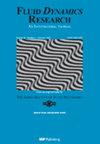不同伸长率矩形圆柱体旋涡脱落的数值模拟
IF 1.3
4区 工程技术
Q3 MECHANICS
引用次数: 1
摘要
在Re=22时,对经过具有不同伸长率(L/D=1、2、4、6、8、10、12、14和16)的矩形圆柱体的流动进行了RANS模拟 000,使用k-ωSST湍流模型。当L/D从1增加到6时,存在斯特劳哈尔数(St)的逐步增加,而在L/D⩾8时,可以发现St相对于L/D的几乎线性变化(St=0.1618*L/D)。在流动中,识别出剪切层下方的两个小的二次涡,后缘二次涡与前缘主涡相比呈现相反的旋转方向。对剪切层和涡流特性进行了分析,以将矩形圆柱体表面的壁面法向应力和剪切应力关联起来。此外,在不同L/D的气缸之间,观察到了前缘涡流(L涡流)和后缘涡流(T涡流)之间的四种耦合模式,分别命名为L涡流模式(即L/D=1–2)、L-T涡流模式(如L/D=4–8)、T-L涡流模式(即L/D=10–14)和T涡流模式。当L/D>4时,L涡和T涡的对流速度对L/D不敏感。本文章由计算机程序翻译,如有差异,请以英文原文为准。
Numerical simulation of vortex shedding from rectangular cylinders with different elongation ratios
RANS simulations are performed for flow past rectangular cylinders with different elongation ratios (L/D= 1, 2, 4, 6, 8, 10, 12, 14 and 16) at Re= 22 000 using the k-ω SST turbulence model. As L/D increases from 1 to 6, stepwise increase of Strouhal number (St) exists, whereas an almost linear variation of St with respect to L/D can be found (St= 0.1618*L/D) at L/D⩾ 8. In the flow, two small secondary vortices beneath the shear layers are identified and the trailing-edge secondary vortex presents opposite rotational direction comparing with the leading-edge main vortex. Analysis of the shear layer and vortex characteristics is carried out to correlate with the wall normal stress and shear stress on the rectangular cylinder surfaces. Further, four coupling modes between leading-edge vortex (L-vortex) and trailing-edge vortex (T-vortex) among cylinders with different L/D are observed, named L-Vortex Mode (i.e. L/D= 1–2), L-T-Vortex Mode (i.e. L/D= 4–8), T-L-Vortex Mode (i.e. L/D= 10–14), and T-Vortex Mode (i.e. L/D ⩾ 16). When L/D > 4, the convective velocity of the L- and T-vortex is not sensitive to the L/D.
求助全文
通过发布文献求助,成功后即可免费获取论文全文。
去求助
来源期刊

Fluid Dynamics Research
物理-力学
CiteScore
2.90
自引率
6.70%
发文量
37
审稿时长
5 months
期刊介绍:
Fluid Dynamics Research publishes original and creative works in all fields of fluid dynamics. The scope includes theoretical, numerical and experimental studies that contribute to the fundamental understanding and/or application of fluid phenomena.
 求助内容:
求助内容: 应助结果提醒方式:
应助结果提醒方式:


